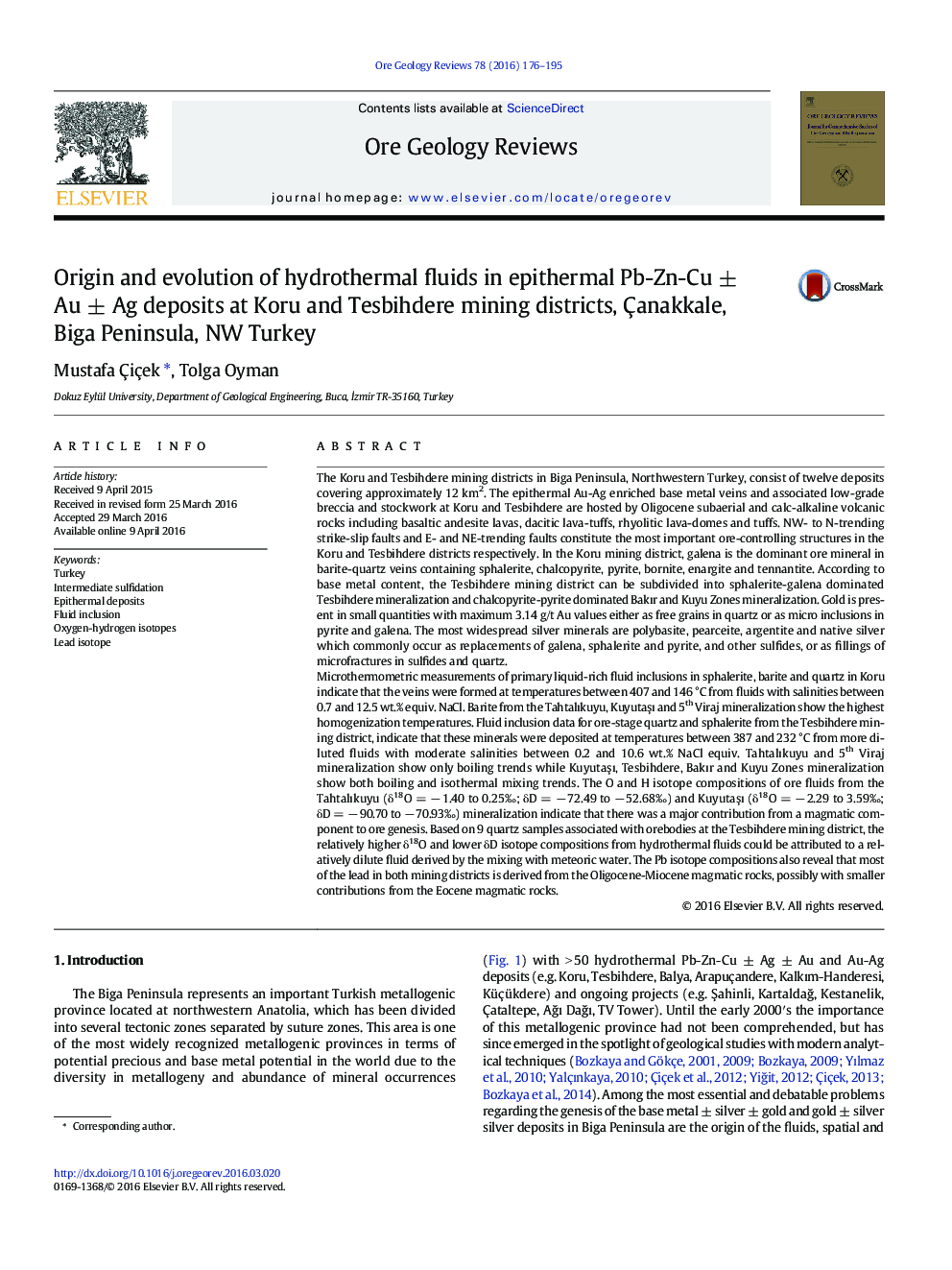| کد مقاله | کد نشریه | سال انتشار | مقاله انگلیسی | نسخه تمام متن |
|---|---|---|---|---|
| 4696847 | 1637228 | 2016 | 20 صفحه PDF | دانلود رایگان |

• Koru region is one of the focal points of Pb-Zn-Cu ± Ag ± Au intermediate sulfidation epithermal deposits in NW Turkey.
• Paragenesis and alteration of each mineralization are consistent with an intermediate sulfidation epithermal deposit type.
• Determinations of temperature-salinity and origin (Pb) of the fluids are responsible for mineralization.
• O and H isotope compositions suggest a mixed character of ore-forming fluids between meteoric and magmatic water.
The Koru and Tesbihdere mining districts in Biga Peninsula, Northwestern Turkey, consist of twelve deposits covering approximately 12 km2. The epithermal Au-Ag enriched base metal veins and associated low-grade breccia and stockwork at Koru and Tesbihdere are hosted by Oligocene subaerial and calc-alkaline volcanic rocks including basaltic andesite lavas, dacitic lava-tuffs, rhyolitic lava-domes and tuffs. NW- to N-trending strike-slip faults and E- and NE-trending faults constitute the most important ore-controlling structures in the Koru and Tesbihdere districts respectively. In the Koru mining district, galena is the dominant ore mineral in barite-quartz veins containing sphalerite, chalcopyrite, pyrite, bornite, enargite and tennantite. According to base metal content, the Tesbihdere mining district can be subdivided into sphalerite-galena dominated Tesbihdere mineralization and chalcopyrite-pyrite dominated Bakır and Kuyu Zones mineralization. Gold is present in small quantities with maximum 3.14 g/t Au values either as free grains in quartz or as micro inclusions in pyrite and galena. The most widespread silver minerals are polybasite, pearceite, argentite and native silver which commonly occur as replacements of galena, sphalerite and pyrite, and other sulfides, or as fillings of microfractures in sulfides and quartz.Microthermometric measurements of primary liquid-rich fluid inclusions in sphalerite, barite and quartz in Koru indicate that the veins were formed at temperatures between 407 and 146 °C from fluids with salinities between 0.7 and 12.5 wt.% equiv. NaCl. Barite from the Tahtalıkuyu, Kuyutaşı and 5th Viraj mineralization show the highest homogenization temperatures. Fluid inclusion data for ore-stage quartz and sphalerite from the Tesbihdere mining district, indicate that these minerals were deposited at temperatures between 387 and 232 °C from more diluted fluids with moderate salinities between 0.2 and 10.6 wt.% NaCl equiv. Tahtalıkuyu and 5th Viraj mineralization show only boiling trends while Kuyutaşı, Tesbihdere, Bakır and Kuyu Zones mineralization show both boiling and isothermal mixing trends. The O and H isotope compositions of ore fluids from the Tahtalıkuyu (δ18O = − 1.40 to 0.25‰; δD = − 72.49 to − 52.68‰) and Kuyutaşı (δ18O = − 2.29 to 3.59‰; δD = − 90.70 to − 70.93‰) mineralization indicate that there was a major contribution from a magmatic component to ore genesis. Based on 9 quartz samples associated with orebodies at the Tesbihdere mining district, the relatively higher δ18O and lower δD isotope compositions from hydrothermal fluids could be attributed to a relatively dilute fluid derived by the mixing with meteoric water. The Pb isotope compositions also reveal that most of the lead in both mining districts is derived from the Oligocene-Miocene magmatic rocks, possibly with smaller contributions from the Eocene magmatic rocks.
Figure optionsDownload as PowerPoint slide
Journal: Ore Geology Reviews - Volume 78, October 2016, Pages 176–195